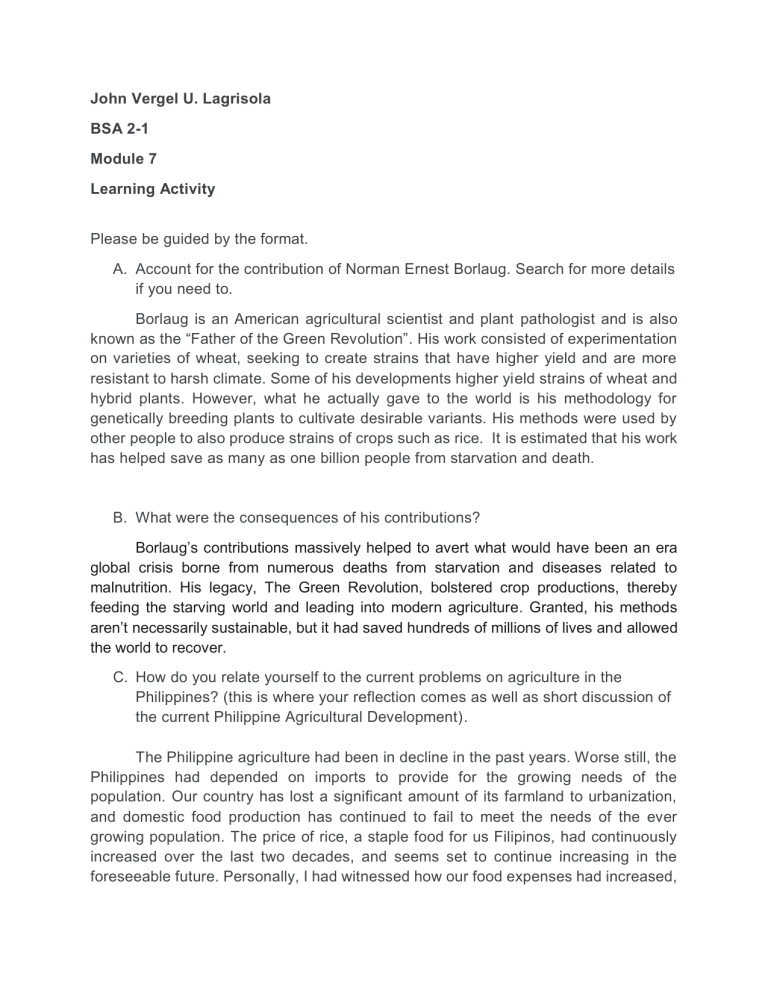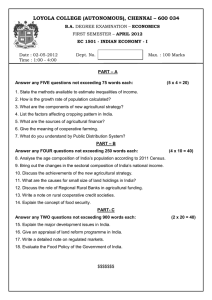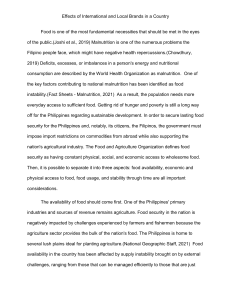
John Vergel U. Lagrisola BSA 2-1 Module 7 Learning Activity Please be guided by the format. A. Account for the contribution of Norman Ernest Borlaug. Search for more details if you need to. Borlaug is an American agricultural scientist and plant pathologist and is also known as the “Father of the Green Revolution”. His work consisted of experimentation on varieties of wheat, seeking to create strains that have higher yield and are more resistant to harsh climate. Some of his developments higher yield strains of wheat and hybrid plants. However, what he actually gave to the world is his methodology for genetically breeding plants to cultivate desirable variants. His methods were used by other people to also produce strains of crops such as rice. It is estimated that his work has helped save as many as one billion people from starvation and death. B. What were the consequences of his contributions? Borlaug’s contributions massively helped to avert what would have been an era global crisis borne from numerous deaths from starvation and diseases related to malnutrition. His legacy, The Green Revolution, bolstered crop productions, thereby feeding the starving world and leading into modern agriculture. Granted, his methods aren’t necessarily sustainable, but it had saved hundreds of millions of lives and allowed the world to recover. C. How do you relate yourself to the current problems on agriculture in the Philippines? (this is where your reflection comes as well as short discussion of the current Philippine Agricultural Development). The Philippine agriculture had been in decline in the past years. Worse still, the Philippines had depended on imports to provide for the growing needs of the population. Our country has lost a significant amount of its farmland to urbanization, and domestic food production has continued to fail to meet the needs of the ever growing population. The price of rice, a staple food for us Filipinos, had continuously increased over the last two decades, and seems set to continue increasing in the foreseeable future. Personally, I had witnessed how our food expenses had increased, and how our food budget become tighter still. Where we used to indulge ourselves with a bit more expensive food once in a while or go out to eat, now we had to reduce budget for other expenses and even draw on our savings to fulfill our needs. Knowledge of this matter has led me to realize that if the current situation is not improved, our country will be severely hamstringed by the lack of food. Even if my family manages to be selfsufficient, the economy is likely to be crippled, and the Philippines will remain poor. D. Do you agree on the Balik-Probinsya Program of the Government? Explain your answer. Yes, I agree with the Balik-Probinsya Program. If implemented true to its goals, the program would increase the rate of national development, given that instead of the NCR spearheading growth and leaving other areas behind, the program would distribute resources to other areas, thereby achieving development all across the board. As it is right now, areas in the NCR are increasingly crowded, and despite being developed, is not really desirable to live in for the average person. And yet, people flock to these areas to experience the boons of economic growth while hopefully earning a living. However, to put it bluntly, some people had become a hindrance to development of these regions, deducting to economic growth rather than contributing into it. The Balik-Probinsya Program, once fully realized, will bring these developments into other areas, leading to better quality of life, better utilization of resources, and further development of local industries, which in turn leads to faster overall national economic growth and ushering in economic development. E. What are the needed resources for this program? The short answer is money and human capital. For nearly everything, money is needed. From transportation of relocated people, to providing a starting allowance, encouraging business investments, research and development for technological improvements necessary to improve local industries, building facilities, and many more, money is needed. However, money is worthless if those who have it can’t utilize it properly. Hence the human capital. Aside from industry experts who will lead the development of countryside areas, it is also necessary to invest in the development of the people in the countryside themselves. Education and Health are the bare minimum for productive citizens, and this will require money, too. More productive citizens equate to a better economy, which fuels a positive feedback loop of increased economic growth and better lives for citizens. Self-Assessment Questions 1. Describe an agricultural transformation. 5 pts Agricultural transformation refers to how agricultural systems progress from being focused on subsistence to being commercialized and having increased productivity. It entails increased technological application and more sophisticated methodologies that increase both efficiency and productivity. The transformation is also entwined with the goal of farming, which moves from merely providing for consumption needs to capitalizing on the market for food production. 2. What are the phases of rural development? 5 pts Phase 1: Establishing the basics. Widespread agriculture but low productivity. To grow from this stage, infrastructure, research and land reforms are necessary. Phase 2: Kick Starting Market. In this phase, the necessities are fulfilled and profitable technology are existent, but financial and market constraints limit the uptake. Progressing from this phase requires capital investment and the availability of a market. Phase 3: Withdrawal. In this phase, the agricultural sector is mostly privatized, and along with non-agricultural products, has acquired markets and finances. 3. What are the steps in Rural Development? 5 pts The steps in rural development are: 1. Regulation of markets to create orderly and transparent marketing conditions which benefitted both farmers and consumers. 2. Improving and developing infrastructure facilities like roads, railways, transport, warehousing, cold storages and processing units. 3. Co-operative marketing which helps the farmers realise a fair price for their products. 4. Safeguarding interests of the farmers by initiating certain policies like minimum support prices for agricultural products, maintaining and storing buffer stock of food grains and establishing a Public Distribution System to distribute food grains and other products. 4. What are the steps that Philippines should take in order to achieve rural development? In order to achieve rural development, the Philippines needs to do the following: First is to stabilize the economy of rural areas by providing for agricultural development and allocating funds for local industries and education. Next is to allocate even more funding for development projects to utilize the growing population of educated people as well as the stable economy, in order to attract investments from the private sector. Lastly, the Philippines needs to curb the rapid, wasteful growth and transition into more sustainable improvements so as to not overtax the environment and lead to problems in the future.




